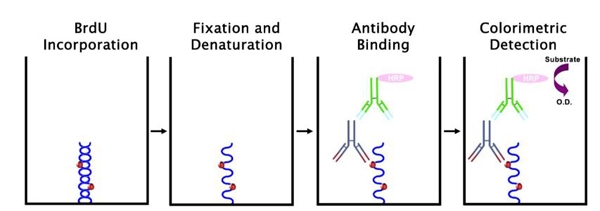BrdU Cell Proliferation Assay
Introduction
Cell proliferation is an important indicator to understand the mechanisms of certain genes, proteins and pathways involved in cell survival or death after exposing to toxic substances. Generally, the cell proliferation assays are used for drug screening to detect whether the test molecules have effects on cell proliferation or display direct cytotoxic effects. Measuring the synthesis of new DNA is the most precise method to assay cell proliferation. Halogenated nucleotides such as the pyrimidine analog bromodeoxyuridine (BrdU) can be used to label nascent DNA in living cells. During the process of DNA replication, BrdU can replace thymidine and incorporate into the newly synthesized DNA of actively dividing cells. Since the BrdU reagent does not cross react with endogenous DNA, cell proliferation thus can be reflected in the extent of BrdU incorporation by determining the absorption intensity of the final reaction. The BrdU cell proliferation assay is a versatile and convenient method for quantification of cell proliferation.
 Figure 1. Schematic of the BrdU cell proliferation assay.
Figure 1. Schematic of the BrdU cell proliferation assay.
Applications
- Detection and quantification of cell proliferation induced by cytokines, growth factors, mitogens, and nutrients.
- Analysis of cytotoxic or cytostatic compounds such as anticancer drugs, toxic agents, and other pharmaceuticals.
- Determination of the inhibitory or stimulatory effects of various compounds on cell proliferation.
Sample Type
- Adherent and suspension cells
Materials
- BrdU solution
- Fixing/denaturing solution
- BrdU detection antibody
- HRP-labeled antibody
- Wash buffer
- TMB substrate
- Stop solution
- Multi-well microplate reader
BrdU Cell Proliferation Assay Procedure
- Plate cells in a 96-well plate and incubate for required time depending upon the cell type. Treat cells with desired compounds for 1-72 hour (s).
- Add BrdU solution into desired wells with a final concentration of 1X.
- Incubate plate at 37°C for 1-4 hour (s).
Note: 1) Seed cells at a density of 2,500-10,000 cells/well depending on the cell growth rate. 2) Incubation time needs to be optimized for different cell lines. - Remove medium from cells and add 100 µL of fixing/denaturing solution into each well.
Note: For detection of the BrdU label by the anti-BrdU monoclonal antibody, it is necessary to fix the cells and denature the DNA using fixing solution. - Incubate at room temperature for 30 min.
- Remove solution carefully and add 100 μL of BrdU detection antibody solution into each well.
- Incubate at room temperature for 1 hour with gentle shaking.
- Remove solution and wash wells with 300 μL wash buffer (2 times).
- After washing, add 100 μL of HRP-labeled antibody solution into each well and incubate the plate at room temperature for 1 hour.
- Remove solution and wash wells with 300 μL of wash buffer (3 times).
- Add 100 µL TMB substrate into each well and measure the absorbance at 650 nm for 5-30 min, monitoring the color development at room temperature.
- To stop the color development by adding 100 μL stop solution into each well and measure the absorbance at 450 nm.
Notes: 1) For suspension cells, centrifuge plate at 300 g for 10 min and remove medium carefully before adding fixing/denaturing solution. 2) The incubation time after addition of TMB substrate must be optimized to avoid over development of the color. After addition of stop solution, read plate immediately. 3) Recommended absorbance is 0.8-1 and the value from OD 450 nm will be approximately twice of that from OD 650 nm.
References
- Rothaeusler K. et al.; Assessment of cell proliferation by 5-bromodeoxyuridine (BrdU) labeling for multicolor flow cytometry. Current Protocols in Cytometry, 2007, 7 (31): 1-13.
- Kennedy B. K. et al.; Nuclear organization of DNA replication in primary mammalian cells. Genes Dev, 2000, 15, 2855-2868.
Cell Services:
Cell Line Testing and Assays:
Explore Other Options